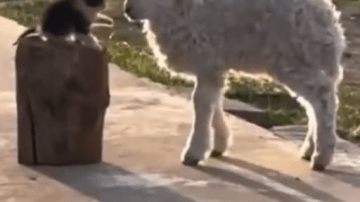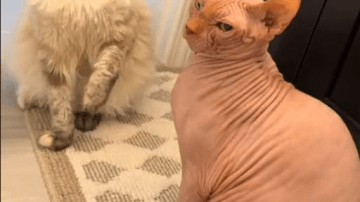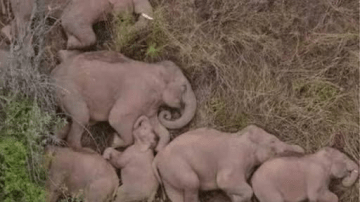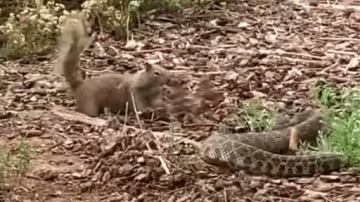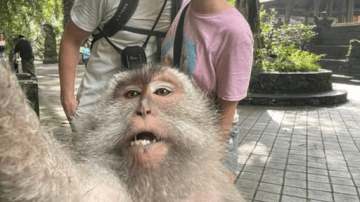On a quiet morning, a kind passerby noticed something unusual lying motionless on the roadside. At first glance, it looked like a pile of rags. But then the small shape twitched. As the woman approached, she realized it was a puppy — fragile, trembling, and barely breathing.

The tiny creature was curled around a discarded milk carton, pressing her body against it as if it were her last source of warmth and comfort. Her fur was dirty and matted, her eyes glassy with exhaustion. Yet even in such despair, she clung to life.
The woman knelt beside her and gently whispered, “It’s okay, little one. You’re safe now.” She placed a small piece of food near the puppy’s mouth. At first, the little dog didn’t respond. Then, with incredible effort, she licked it. She ate slowly, each bite giving her a little more strength. After eating, she managed to stand on shaky legs, taking a few unsteady steps before collapsing again.
It was clear she was gravely ill. Her breathing was shallow, her body twitching with involuntary spasms. The woman’s heart broke at the sight. She knew this puppy wouldn’t survive long on the streets — not alone, not like this. Without hesitation, she decided to take her to the nearest animal hospital.
A Race Against Time
On the way to the hospital, the puppy lay still in her rescuer’s arms. Exhausted, she finally drifted into a peaceful sleep for the first time in what must have been days. The woman drove as fast as she could, praying that it wasn’t too late.
At the clinic, the veterinarians began examining her immediately. After several tests, the doctor’s face turned somber. The puppy was diagnosed with canine distemper, a highly contagious and deadly virus that attacks the nervous system.
“She’s in the advanced stage,” the vet said softly. “There’s severe inflammation, nerve damage, and anemia. She’s only a month old. It’s going to be very hard.”
The woman felt tears in her eyes but refused to give up. “Do everything you can,” she said. “She deserves a chance.”
The medical team began emergency treatment that same night. They placed her in an isolation ward to protect other animals. The little fighter was given fluids, antibiotics, and antiviral medication. Despite the slim chances, everyone decided to fight for her. They named her Milky, after the empty milk carton she had clung to for survival.

Milky’s First Days in the Hospital
Milky’s condition was critical. Her small body twitched constantly due to nerve damage. Even when she slept, her legs jerked uncontrollably. Her cries of pain echoed through the hallway, breaking the hearts of everyone who heard her.
When awake, she whimpered softly, her little face scrunched in agony. But whenever someone picked her up, she would stop crying. She would relax in the warmth of human arms, and finally drift into a quiet sleep.
By the third day, Milky had survived longer than anyone expected. She began eating small portions of food on her own. Though still frail and trembling, her spirit showed signs of fight. The vets increased her feedings to help her gain strength.
“Keep going, Milky,” one nurse whispered as she petted her gently. “Don’t give up.”
Milky responded with a faint wag of her tail.
A Glimmer of Hope
On the fourth day, something remarkable happened. Milky, though unsteady, tried to stand. Her legs wobbled under her, but she managed to take a few steps before falling. The staff cheered softly, amazed at her courage. It was a fragile sign of life, but it was enough to give everyone hope.
Over the next few days, Milky became more attached to her rescuer. Every time the woman tried to leave, Milky cried out anxiously, her tiny paws scratching at the air as if to say, “Please don’t go.”
Her playful side began to show. She started exploring corners of the hospital, sniffing curiously at her surroundings before returning to her rescuer for cuddles.
Everyone began to believe that maybe, just maybe, this little puppy could survive.

The Turning Point: Stem Cell Therapy
On the fifth day, doctors introduced a new plan — stem cell treatment, a modern therapy that had shown promise for dogs suffering from distemper. It was expensive, but the rescuers didn’t hesitate. Milky deserved every chance.
The injection was administered, and soon after, Milky developed a high fever. Her body was fighting the virus with everything it had. The medical team worked tirelessly through the night, wiping her down to keep her temperature under control. It was a long and sleepless night for everyone.
By morning, her fever finally broke. But the effort had drained her completely. She could no longer stand. Her eyes flickered weakly as she tried to stay awake.
Still, she fought on.
Days of Struggle and Courage
By the seventh day, the medical staff had done everything possible. Milky remained in critical condition, but she was still alive. For such a tiny body, her will to survive was incredible. Every night, the rescuers took turns sitting by her side, whispering encouragements.
On the eighth day, her fever returned. She vomited often and struggled to keep food down. Volunteers patiently fed her again and again, one drop at a time. Despite the pain, Milky tried to eat on her own. That small act gave everyone renewed strength.

But her condition was unpredictable. Some moments she seemed better; others, she slipped back into weakness. Her body trembled from convulsions, and her breathing became shallow. The doctors tried oxygen therapy to ease her suffering. “Milky,” her rescuer whispered, holding her paw, “if you can hear me, stay with us. I’ll be right here.”
The Final Battle
By the tenth day, the staff was astonished that Milky had survived this long. Her tests still showed no improvement, yet she refused to let go. She barely slept, her small body constantly trembling. Finally, around noon, she fell into a deep sleep — her first in many hours.
The next day, her breathing grew heavier, her nose running as the infection worsened. The medical team carefully cleaned her face, using a straw to remove the mucus so she could breathe easier. “If she can get through this,” the vet said quietly, “there’s still hope.”
That night, Milky fell asleep again, her tiny chest rising and falling gently. For a moment, everyone dared to believe she might make it.
But the following morning, her condition suddenly worsened. Despite all efforts, Milky’s little heart began to slow. The team worked desperately to save her, but she was too weak.
After twelve long days of fighting, Milky took her final breath.
She passed peacefully, her face relaxed, free from pain for the first time. There were no more convulsions, no more cries. She looked as if she had simply fallen asleep.

Remembering Milky
The clinic fell silent. The rescuers and veterinarians who had fought so hard for her wiped away tears. Though her life was short, Milky had left a deep mark on everyone who met her.
For twelve days, she had shown the world what true courage looked like. Despite constant pain, she never stopped fighting. She responded to kindness with trust, to suffering with silent strength.
Her rescuer whispered softly, “If only I had found you earlier, maybe things would have been different. But at least, in your final days, you were not alone.”
Milky was given a small burial, wrapped in a soft blanket. Flowers were placed beside her, along with a small milk carton — a reminder of how she was first found, clinging to it for comfort.
A Legacy of Hope
Milky’s story touched thousands who heard it. She became a symbol of resilience and love — a reminder that even the smallest life matters. Though she didn’t survive, she experienced kindness and warmth in her final moments. She left this world knowing she was cared for.
Her story continues to inspire rescuers to never give up, to stop for the animals others overlook, and to believe in miracles, even when they seem impossible.
Milky’s short life reminds us that compassion can transform even the saddest story into one of love and dignity. She may be gone, but her spirit lives on in every act of kindness that follows.

